Entrepreneurial Ventures and Mindset: A Comprehensive Report (Unit 9)
VerifiedAdded on 2022/11/25
|19
|2648
|300
Report
AI Summary
This report, focusing on entrepreneurship and small business management, delves into the core concepts of entrepreneurial ventures. Part 1 examines different types of entrepreneurs and their topologies, comparing and contrasting them, and analyzing statistical data to assess the impact of micro and small businesses. It also explores the value of small businesses in fostering social economy growth. Part 2 shifts the focus to the entrepreneurial mindset, identifying essential leadership, listening, and solution-oriented skills, along with key traits such as risk-taking, networking, and negotiation. The report further highlights the influence of family upbringing and cultural differences on entrepreneurial success, providing a comprehensive overview of the subject matter.

Entrepreneurship
and small business
management
and small business
management
Paraphrase This Document
Need a fresh take? Get an instant paraphrase of this document with our AI Paraphraser

Contents
INTRODUCTION...........................................................................................................................3
MAIN BODY...................................................................................................................................3
Part 1................................................................................................................................................3
P1. Types of entrepreneur and topologies..............................................................................3
P2. Similarities and differences in these types of ventures....................................................4
P3. Analyse statistical data analyse the impact of micro and small business.........................6
P4 What is the value of small businesses in the growth of social economy..........................7
CONCLUSION................................................................................................................................8
PART 2............................................................................................................................................9
REFERENCES..............................................................................................................................18
Books and Journals...............................................................................................................18
INTRODUCTION...........................................................................................................................3
MAIN BODY...................................................................................................................................3
Part 1................................................................................................................................................3
P1. Types of entrepreneur and topologies..............................................................................3
P2. Similarities and differences in these types of ventures....................................................4
P3. Analyse statistical data analyse the impact of micro and small business.........................6
P4 What is the value of small businesses in the growth of social economy..........................7
CONCLUSION................................................................................................................................8
PART 2............................................................................................................................................9
REFERENCES..............................................................................................................................18
Books and Journals...............................................................................................................18
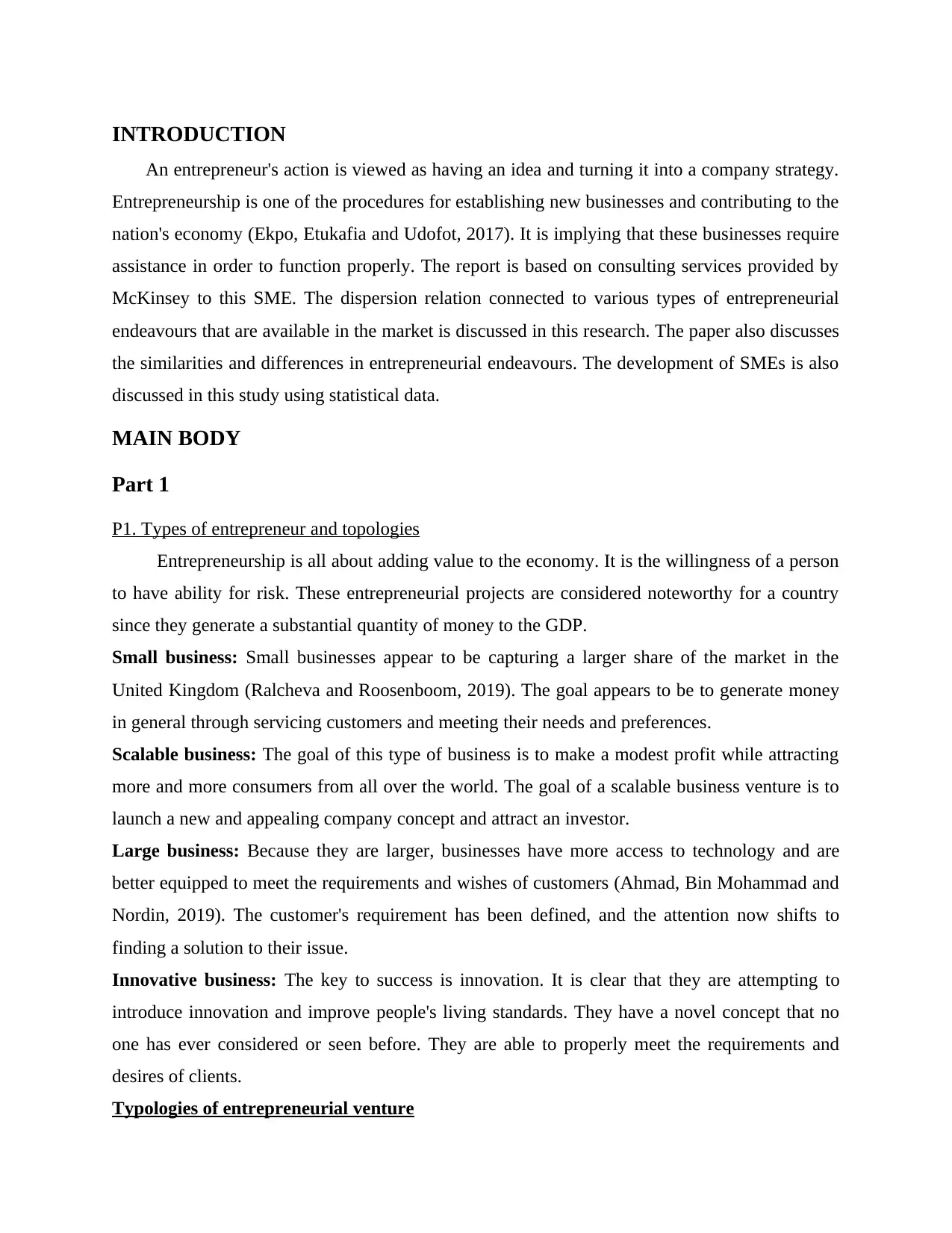
INTRODUCTION
An entrepreneur's action is viewed as having an idea and turning it into a company strategy.
Entrepreneurship is one of the procedures for establishing new businesses and contributing to the
nation's economy (Ekpo, Etukafia and Udofot, 2017). It is implying that these businesses require
assistance in order to function properly. The report is based on consulting services provided by
McKinsey to this SME. The dispersion relation connected to various types of entrepreneurial
endeavours that are available in the market is discussed in this research. The paper also discusses
the similarities and differences in entrepreneurial endeavours. The development of SMEs is also
discussed in this study using statistical data.
MAIN BODY
Part 1
P1. Types of entrepreneur and topologies
Entrepreneurship is all about adding value to the economy. It is the willingness of a person
to have ability for risk. These entrepreneurial projects are considered noteworthy for a country
since they generate a substantial quantity of money to the GDP.
Small business: Small businesses appear to be capturing a larger share of the market in the
United Kingdom (Ralcheva and Roosenboom, 2019). The goal appears to be to generate money
in general through servicing customers and meeting their needs and preferences.
Scalable business: The goal of this type of business is to make a modest profit while attracting
more and more consumers from all over the world. The goal of a scalable business venture is to
launch a new and appealing company concept and attract an investor.
Large business: Because they are larger, businesses have more access to technology and are
better equipped to meet the requirements and wishes of customers (Ahmad, Bin Mohammad and
Nordin, 2019). The customer's requirement has been defined, and the attention now shifts to
finding a solution to their issue.
Innovative business: The key to success is innovation. It is clear that they are attempting to
introduce innovation and improve people's living standards. They have a novel concept that no
one has ever considered or seen before. They are able to properly meet the requirements and
desires of clients.
Typologies of entrepreneurial venture
An entrepreneur's action is viewed as having an idea and turning it into a company strategy.
Entrepreneurship is one of the procedures for establishing new businesses and contributing to the
nation's economy (Ekpo, Etukafia and Udofot, 2017). It is implying that these businesses require
assistance in order to function properly. The report is based on consulting services provided by
McKinsey to this SME. The dispersion relation connected to various types of entrepreneurial
endeavours that are available in the market is discussed in this research. The paper also discusses
the similarities and differences in entrepreneurial endeavours. The development of SMEs is also
discussed in this study using statistical data.
MAIN BODY
Part 1
P1. Types of entrepreneur and topologies
Entrepreneurship is all about adding value to the economy. It is the willingness of a person
to have ability for risk. These entrepreneurial projects are considered noteworthy for a country
since they generate a substantial quantity of money to the GDP.
Small business: Small businesses appear to be capturing a larger share of the market in the
United Kingdom (Ralcheva and Roosenboom, 2019). The goal appears to be to generate money
in general through servicing customers and meeting their needs and preferences.
Scalable business: The goal of this type of business is to make a modest profit while attracting
more and more consumers from all over the world. The goal of a scalable business venture is to
launch a new and appealing company concept and attract an investor.
Large business: Because they are larger, businesses have more access to technology and are
better equipped to meet the requirements and wishes of customers (Ahmad, Bin Mohammad and
Nordin, 2019). The customer's requirement has been defined, and the attention now shifts to
finding a solution to their issue.
Innovative business: The key to success is innovation. It is clear that they are attempting to
introduce innovation and improve people's living standards. They have a novel concept that no
one has ever considered or seen before. They are able to properly meet the requirements and
desires of clients.
Typologies of entrepreneurial venture
⊘ This is a preview!⊘
Do you want full access?
Subscribe today to unlock all pages.

Trusted by 1+ million students worldwide
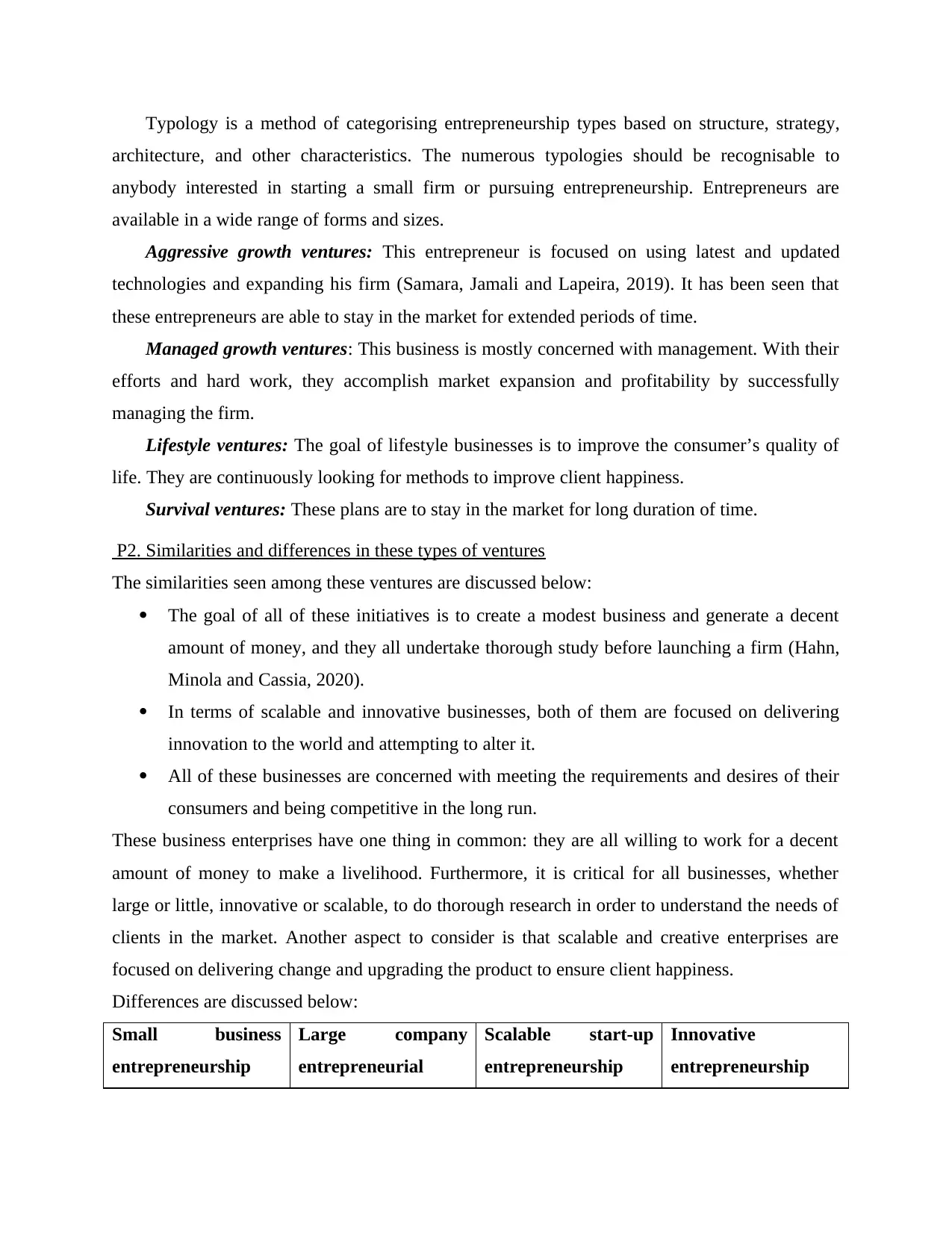
Typology is a method of categorising entrepreneurship types based on structure, strategy,
architecture, and other characteristics. The numerous typologies should be recognisable to
anybody interested in starting a small firm or pursuing entrepreneurship. Entrepreneurs are
available in a wide range of forms and sizes.
Aggressive growth ventures: This entrepreneur is focused on using latest and updated
technologies and expanding his firm (Samara, Jamali and Lapeira, 2019). It has been seen that
these entrepreneurs are able to stay in the market for extended periods of time.
Managed growth ventures: This business is mostly concerned with management. With their
efforts and hard work, they accomplish market expansion and profitability by successfully
managing the firm.
Lifestyle ventures: The goal of lifestyle businesses is to improve the consumer’s quality of
life. They are continuously looking for methods to improve client happiness.
Survival ventures: These plans are to stay in the market for long duration of time.
P2. Similarities and differences in these types of ventures
The similarities seen among these ventures are discussed below:
The goal of all of these initiatives is to create a modest business and generate a decent
amount of money, and they all undertake thorough study before launching a firm (Hahn,
Minola and Cassia, 2020).
In terms of scalable and innovative businesses, both of them are focused on delivering
innovation to the world and attempting to alter it.
All of these businesses are concerned with meeting the requirements and desires of their
consumers and being competitive in the long run.
These business enterprises have one thing in common: they are all willing to work for a decent
amount of money to make a livelihood. Furthermore, it is critical for all businesses, whether
large or little, innovative or scalable, to do thorough research in order to understand the needs of
clients in the market. Another aspect to consider is that scalable and creative enterprises are
focused on delivering change and upgrading the product to ensure client happiness.
Differences are discussed below:
Small business
entrepreneurship
Large company
entrepreneurial
Scalable start-up
entrepreneurship
Innovative
entrepreneurship
architecture, and other characteristics. The numerous typologies should be recognisable to
anybody interested in starting a small firm or pursuing entrepreneurship. Entrepreneurs are
available in a wide range of forms and sizes.
Aggressive growth ventures: This entrepreneur is focused on using latest and updated
technologies and expanding his firm (Samara, Jamali and Lapeira, 2019). It has been seen that
these entrepreneurs are able to stay in the market for extended periods of time.
Managed growth ventures: This business is mostly concerned with management. With their
efforts and hard work, they accomplish market expansion and profitability by successfully
managing the firm.
Lifestyle ventures: The goal of lifestyle businesses is to improve the consumer’s quality of
life. They are continuously looking for methods to improve client happiness.
Survival ventures: These plans are to stay in the market for long duration of time.
P2. Similarities and differences in these types of ventures
The similarities seen among these ventures are discussed below:
The goal of all of these initiatives is to create a modest business and generate a decent
amount of money, and they all undertake thorough study before launching a firm (Hahn,
Minola and Cassia, 2020).
In terms of scalable and innovative businesses, both of them are focused on delivering
innovation to the world and attempting to alter it.
All of these businesses are concerned with meeting the requirements and desires of their
consumers and being competitive in the long run.
These business enterprises have one thing in common: they are all willing to work for a decent
amount of money to make a livelihood. Furthermore, it is critical for all businesses, whether
large or little, innovative or scalable, to do thorough research in order to understand the needs of
clients in the market. Another aspect to consider is that scalable and creative enterprises are
focused on delivering change and upgrading the product to ensure client happiness.
Differences are discussed below:
Small business
entrepreneurship
Large company
entrepreneurial
Scalable start-up
entrepreneurship
Innovative
entrepreneurship
Paraphrase This Document
Need a fresh take? Get an instant paraphrase of this document with our AI Paraphraser
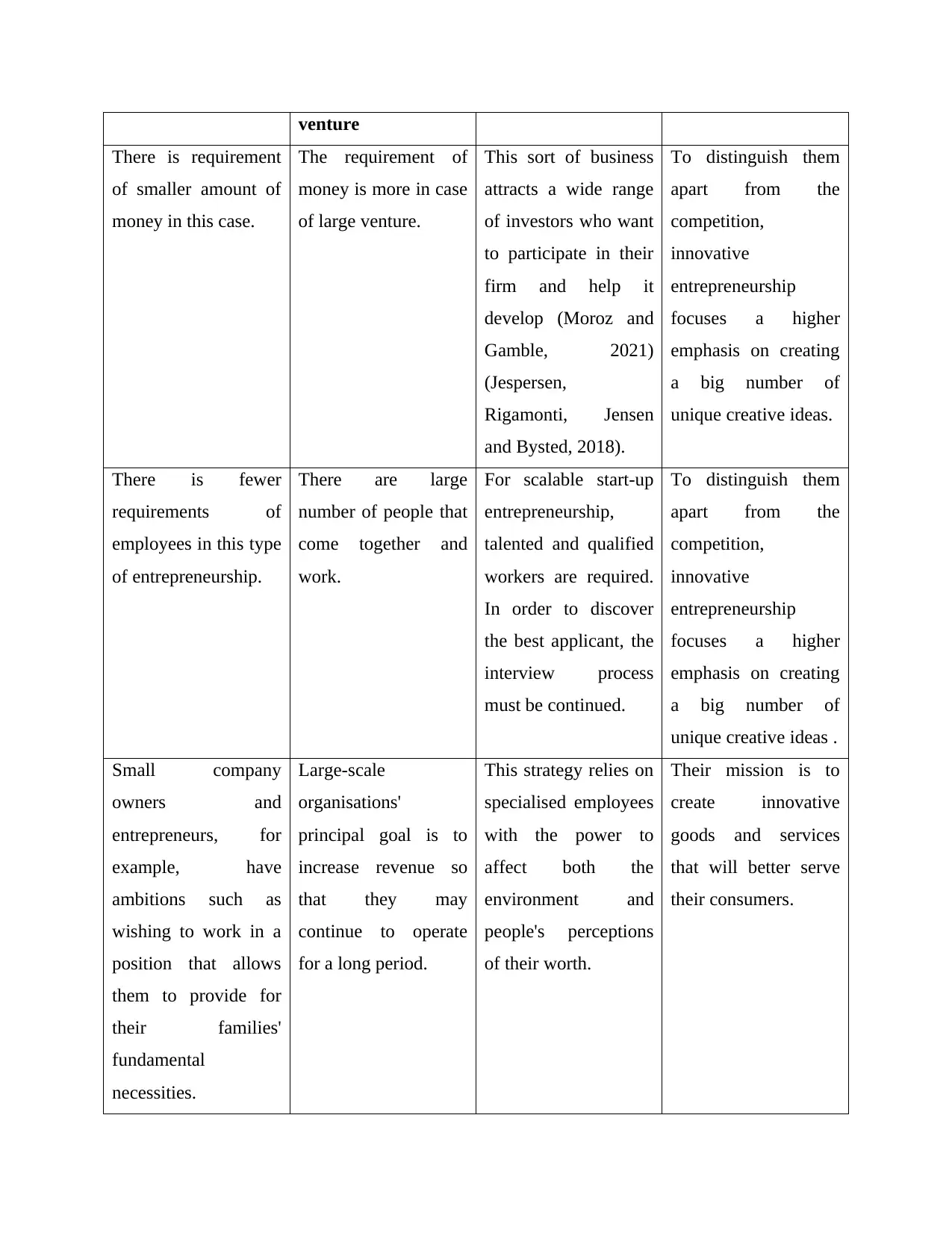
venture
There is requirement
of smaller amount of
money in this case.
The requirement of
money is more in case
of large venture.
This sort of business
attracts a wide range
of investors who want
to participate in their
firm and help it
develop (Moroz and
Gamble, 2021)
(Jespersen,
Rigamonti, Jensen
and Bysted, 2018).
To distinguish them
apart from the
competition,
innovative
entrepreneurship
focuses a higher
emphasis on creating
a big number of
unique creative ideas.
There is fewer
requirements of
employees in this type
of entrepreneurship.
There are large
number of people that
come together and
work.
For scalable start-up
entrepreneurship,
talented and qualified
workers are required.
In order to discover
the best applicant, the
interview process
must be continued.
To distinguish them
apart from the
competition,
innovative
entrepreneurship
focuses a higher
emphasis on creating
a big number of
unique creative ideas .
Small company
owners and
entrepreneurs, for
example, have
ambitions such as
wishing to work in a
position that allows
them to provide for
their families'
fundamental
necessities.
Large-scale
organisations'
principal goal is to
increase revenue so
that they may
continue to operate
for a long period.
This strategy relies on
specialised employees
with the power to
affect both the
environment and
people's perceptions
of their worth.
Their mission is to
create innovative
goods and services
that will better serve
their consumers.
There is requirement
of smaller amount of
money in this case.
The requirement of
money is more in case
of large venture.
This sort of business
attracts a wide range
of investors who want
to participate in their
firm and help it
develop (Moroz and
Gamble, 2021)
(Jespersen,
Rigamonti, Jensen
and Bysted, 2018).
To distinguish them
apart from the
competition,
innovative
entrepreneurship
focuses a higher
emphasis on creating
a big number of
unique creative ideas.
There is fewer
requirements of
employees in this type
of entrepreneurship.
There are large
number of people that
come together and
work.
For scalable start-up
entrepreneurship,
talented and qualified
workers are required.
In order to discover
the best applicant, the
interview process
must be continued.
To distinguish them
apart from the
competition,
innovative
entrepreneurship
focuses a higher
emphasis on creating
a big number of
unique creative ideas .
Small company
owners and
entrepreneurs, for
example, have
ambitions such as
wishing to work in a
position that allows
them to provide for
their families'
fundamental
necessities.
Large-scale
organisations'
principal goal is to
increase revenue so
that they may
continue to operate
for a long period.
This strategy relies on
specialised employees
with the power to
affect both the
environment and
people's perceptions
of their worth.
Their mission is to
create innovative
goods and services
that will better serve
their consumers.
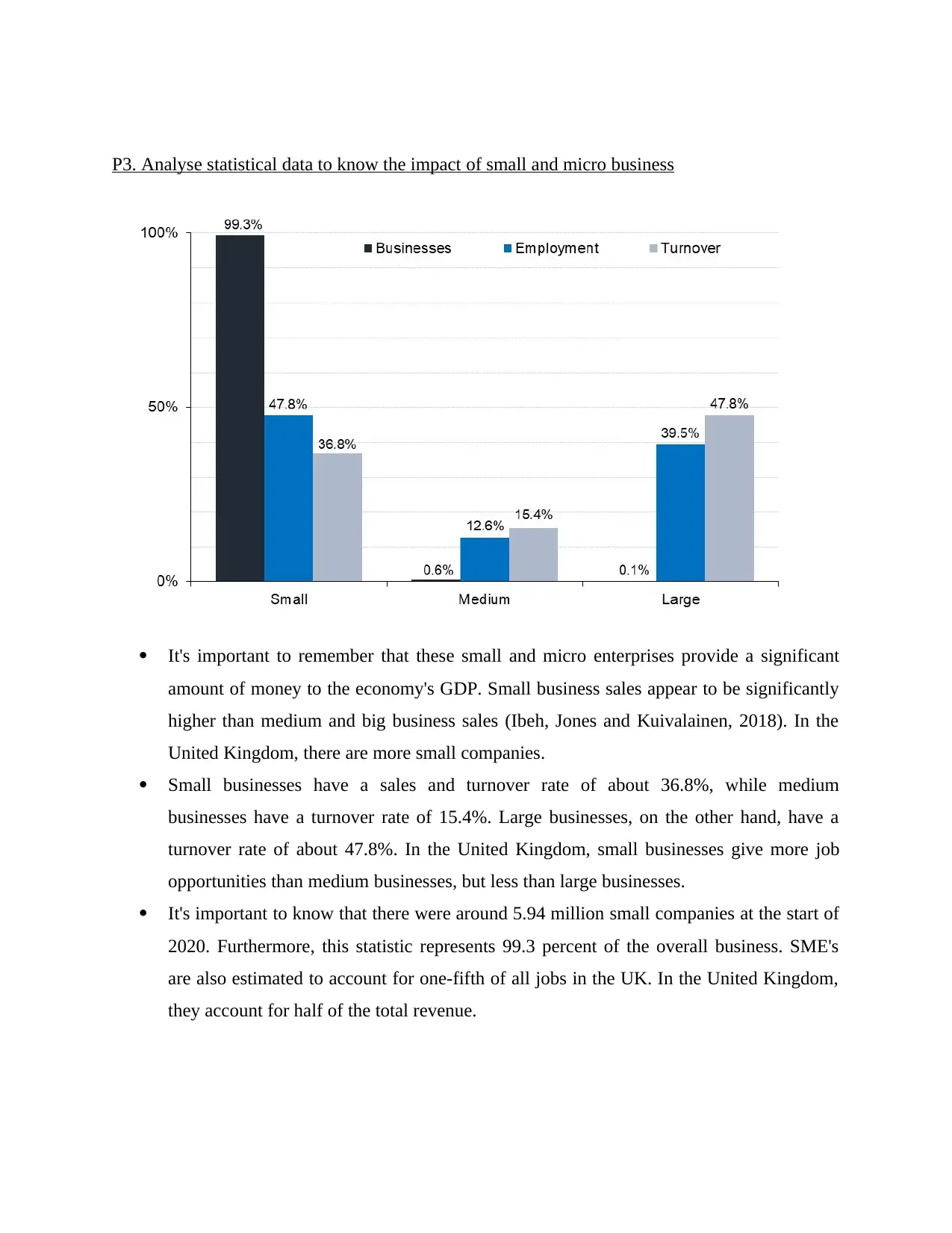
P3. Analyse statistical data to know the impact of small and micro business
It's important to remember that these small and micro enterprises provide a significant
amount of money to the economy's GDP. Small business sales appear to be significantly
higher than medium and big business sales (Ibeh, Jones and Kuivalainen, 2018). In the
United Kingdom, there are more small companies.
Small businesses have a sales and turnover rate of about 36.8%, while medium
businesses have a turnover rate of 15.4%. Large businesses, on the other hand, have a
turnover rate of about 47.8%. In the United Kingdom, small businesses give more job
opportunities than medium businesses, but less than large businesses.
It's important to know that there were around 5.94 million small companies at the start of
2020. Furthermore, this statistic represents 99.3 percent of the overall business. SME's
are also estimated to account for one-fifth of all jobs in the UK. In the United Kingdom,
they account for half of the total revenue.
It's important to remember that these small and micro enterprises provide a significant
amount of money to the economy's GDP. Small business sales appear to be significantly
higher than medium and big business sales (Ibeh, Jones and Kuivalainen, 2018). In the
United Kingdom, there are more small companies.
Small businesses have a sales and turnover rate of about 36.8%, while medium
businesses have a turnover rate of 15.4%. Large businesses, on the other hand, have a
turnover rate of about 47.8%. In the United Kingdom, small businesses give more job
opportunities than medium businesses, but less than large businesses.
It's important to know that there were around 5.94 million small companies at the start of
2020. Furthermore, this statistic represents 99.3 percent of the overall business. SME's
are also estimated to account for one-fifth of all jobs in the UK. In the United Kingdom,
they account for half of the total revenue.
⊘ This is a preview!⊘
Do you want full access?
Subscribe today to unlock all pages.

Trusted by 1+ million students worldwide
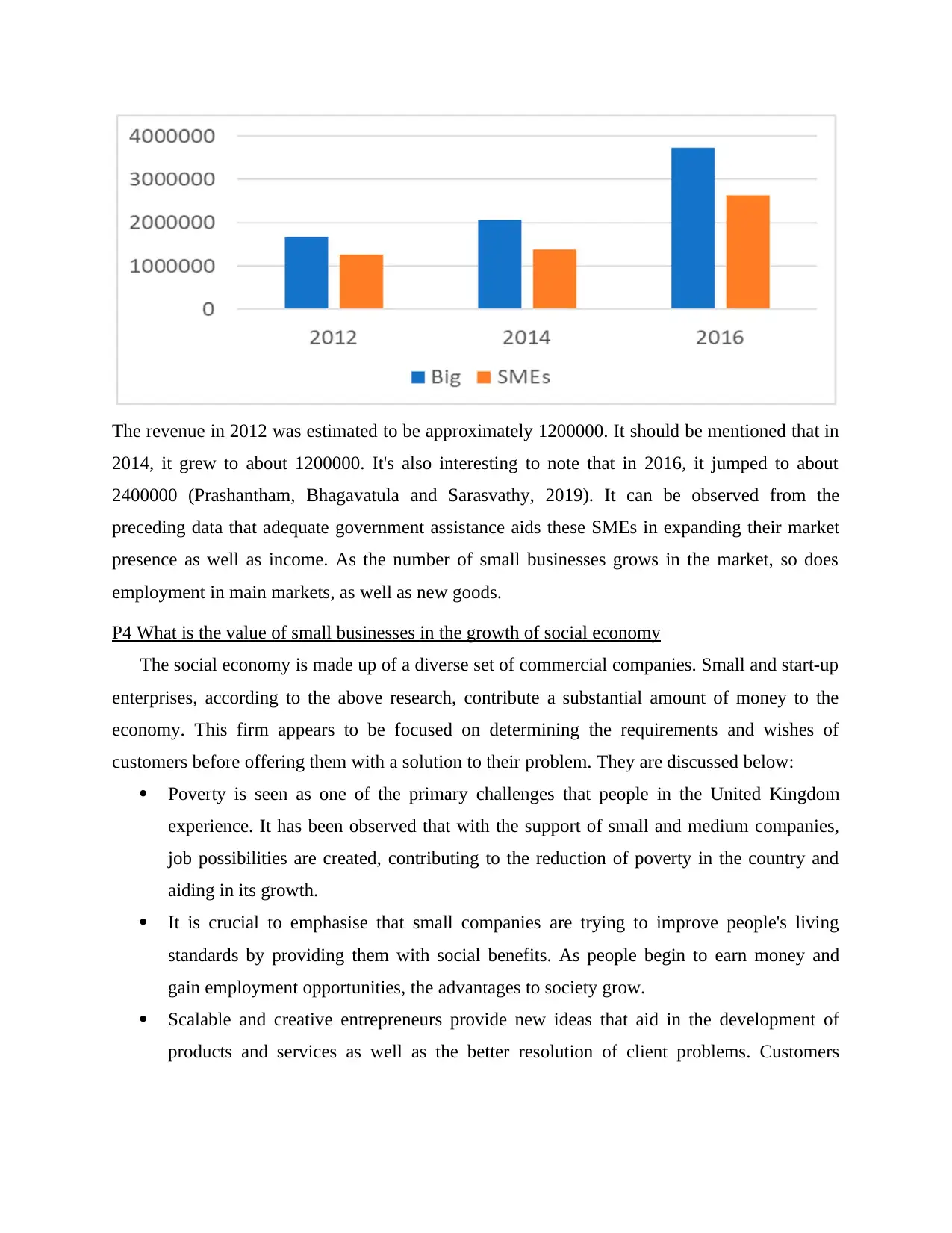
The revenue in 2012 was estimated to be approximately 1200000. It should be mentioned that in
2014, it grew to about 1200000. It's also interesting to note that in 2016, it jumped to about
2400000 (Prashantham, Bhagavatula and Sarasvathy, 2019). It can be observed from the
preceding data that adequate government assistance aids these SMEs in expanding their market
presence as well as income. As the number of small businesses grows in the market, so does
employment in main markets, as well as new goods.
P4 What is the value of small businesses in the growth of social economy
The social economy is made up of a diverse set of commercial companies. Small and start-up
enterprises, according to the above research, contribute a substantial amount of money to the
economy. This firm appears to be focused on determining the requirements and wishes of
customers before offering them with a solution to their problem. They are discussed below:
Poverty is seen as one of the primary challenges that people in the United Kingdom
experience. It has been observed that with the support of small and medium companies,
job possibilities are created, contributing to the reduction of poverty in the country and
aiding in its growth.
It is crucial to emphasise that small companies are trying to improve people's living
standards by providing them with social benefits. As people begin to earn money and
gain employment opportunities, the advantages to society grow.
Scalable and creative entrepreneurs provide new ideas that aid in the development of
products and services as well as the better resolution of client problems. Customers
2014, it grew to about 1200000. It's also interesting to note that in 2016, it jumped to about
2400000 (Prashantham, Bhagavatula and Sarasvathy, 2019). It can be observed from the
preceding data that adequate government assistance aids these SMEs in expanding their market
presence as well as income. As the number of small businesses grows in the market, so does
employment in main markets, as well as new goods.
P4 What is the value of small businesses in the growth of social economy
The social economy is made up of a diverse set of commercial companies. Small and start-up
enterprises, according to the above research, contribute a substantial amount of money to the
economy. This firm appears to be focused on determining the requirements and wishes of
customers before offering them with a solution to their problem. They are discussed below:
Poverty is seen as one of the primary challenges that people in the United Kingdom
experience. It has been observed that with the support of small and medium companies,
job possibilities are created, contributing to the reduction of poverty in the country and
aiding in its growth.
It is crucial to emphasise that small companies are trying to improve people's living
standards by providing them with social benefits. As people begin to earn money and
gain employment opportunities, the advantages to society grow.
Scalable and creative entrepreneurs provide new ideas that aid in the development of
products and services as well as the better resolution of client problems. Customers
Paraphrase This Document
Need a fresh take? Get an instant paraphrase of this document with our AI Paraphraser
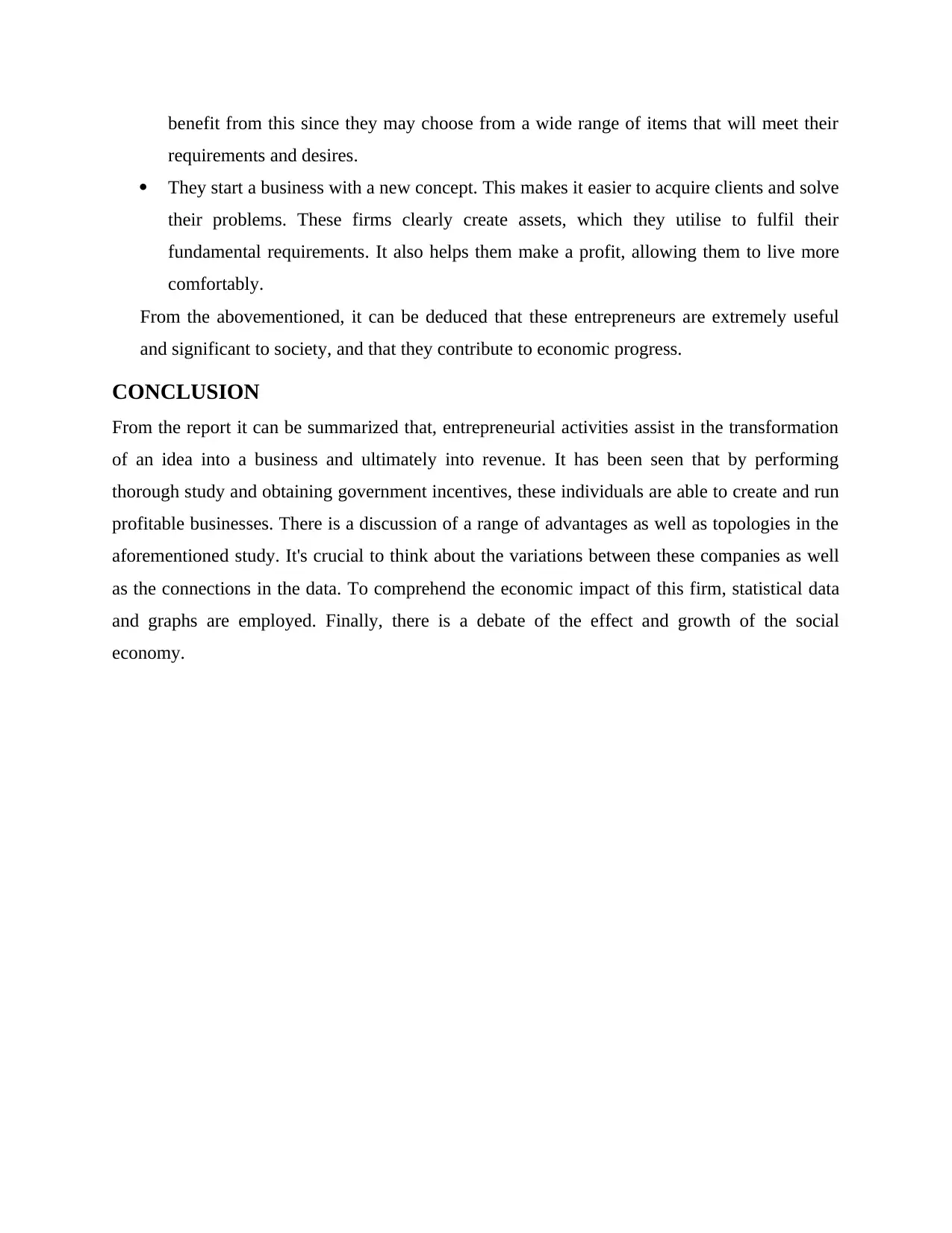
benefit from this since they may choose from a wide range of items that will meet their
requirements and desires.
They start a business with a new concept. This makes it easier to acquire clients and solve
their problems. These firms clearly create assets, which they utilise to fulfil their
fundamental requirements. It also helps them make a profit, allowing them to live more
comfortably.
From the abovementioned, it can be deduced that these entrepreneurs are extremely useful
and significant to society, and that they contribute to economic progress.
CONCLUSION
From the report it can be summarized that, entrepreneurial activities assist in the transformation
of an idea into a business and ultimately into revenue. It has been seen that by performing
thorough study and obtaining government incentives, these individuals are able to create and run
profitable businesses. There is a discussion of a range of advantages as well as topologies in the
aforementioned study. It's crucial to think about the variations between these companies as well
as the connections in the data. To comprehend the economic impact of this firm, statistical data
and graphs are employed. Finally, there is a debate of the effect and growth of the social
economy.
requirements and desires.
They start a business with a new concept. This makes it easier to acquire clients and solve
their problems. These firms clearly create assets, which they utilise to fulfil their
fundamental requirements. It also helps them make a profit, allowing them to live more
comfortably.
From the abovementioned, it can be deduced that these entrepreneurs are extremely useful
and significant to society, and that they contribute to economic progress.
CONCLUSION
From the report it can be summarized that, entrepreneurial activities assist in the transformation
of an idea into a business and ultimately into revenue. It has been seen that by performing
thorough study and obtaining government incentives, these individuals are able to create and run
profitable businesses. There is a discussion of a range of advantages as well as topologies in the
aforementioned study. It's crucial to think about the variations between these companies as well
as the connections in the data. To comprehend the economic impact of this firm, statistical data
and graphs are employed. Finally, there is a debate of the effect and growth of the social
economy.

PART 2
⊘ This is a preview!⊘
Do you want full access?
Subscribe today to unlock all pages.

Trusted by 1+ million students worldwide

Paraphrase This Document
Need a fresh take? Get an instant paraphrase of this document with our AI Paraphraser
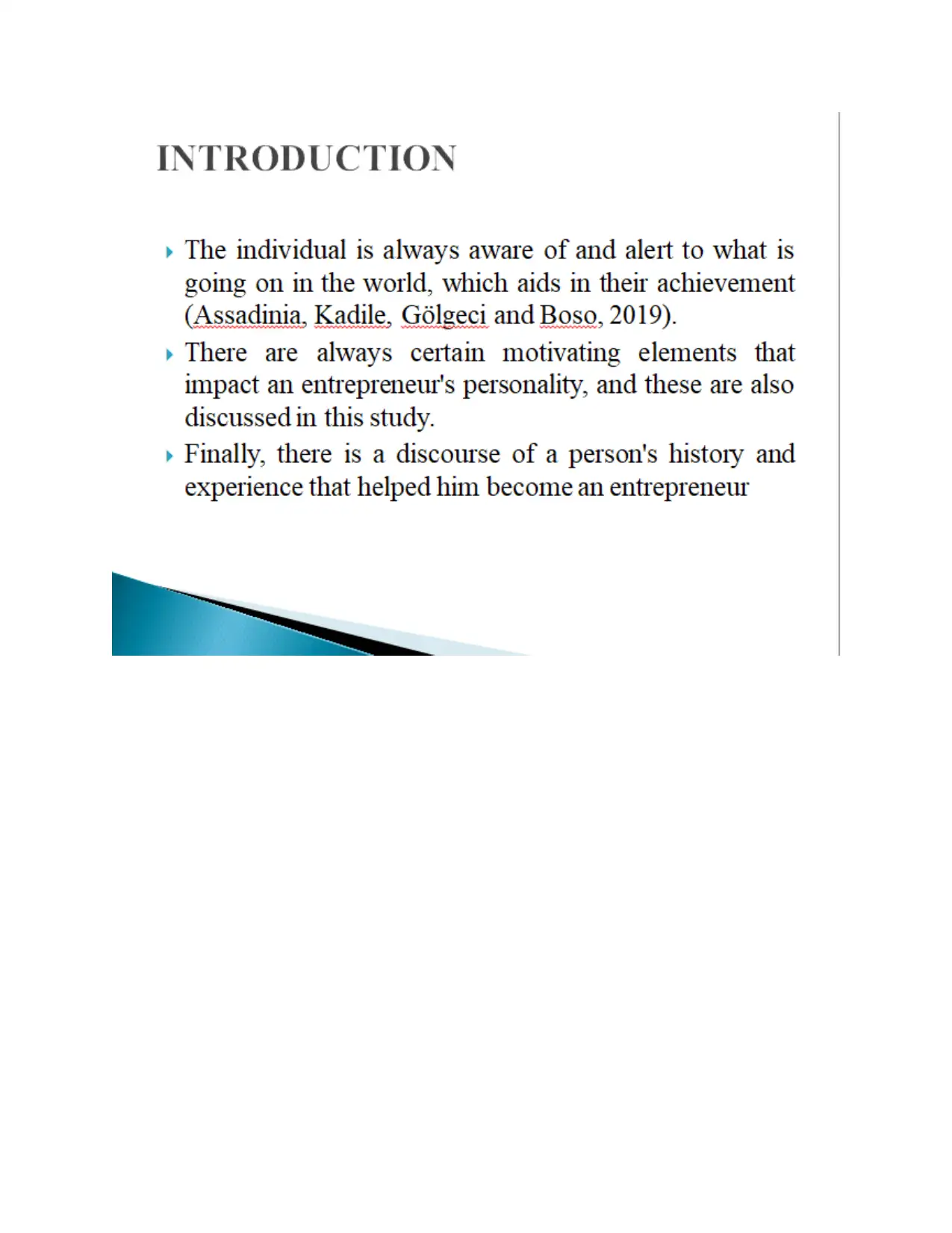
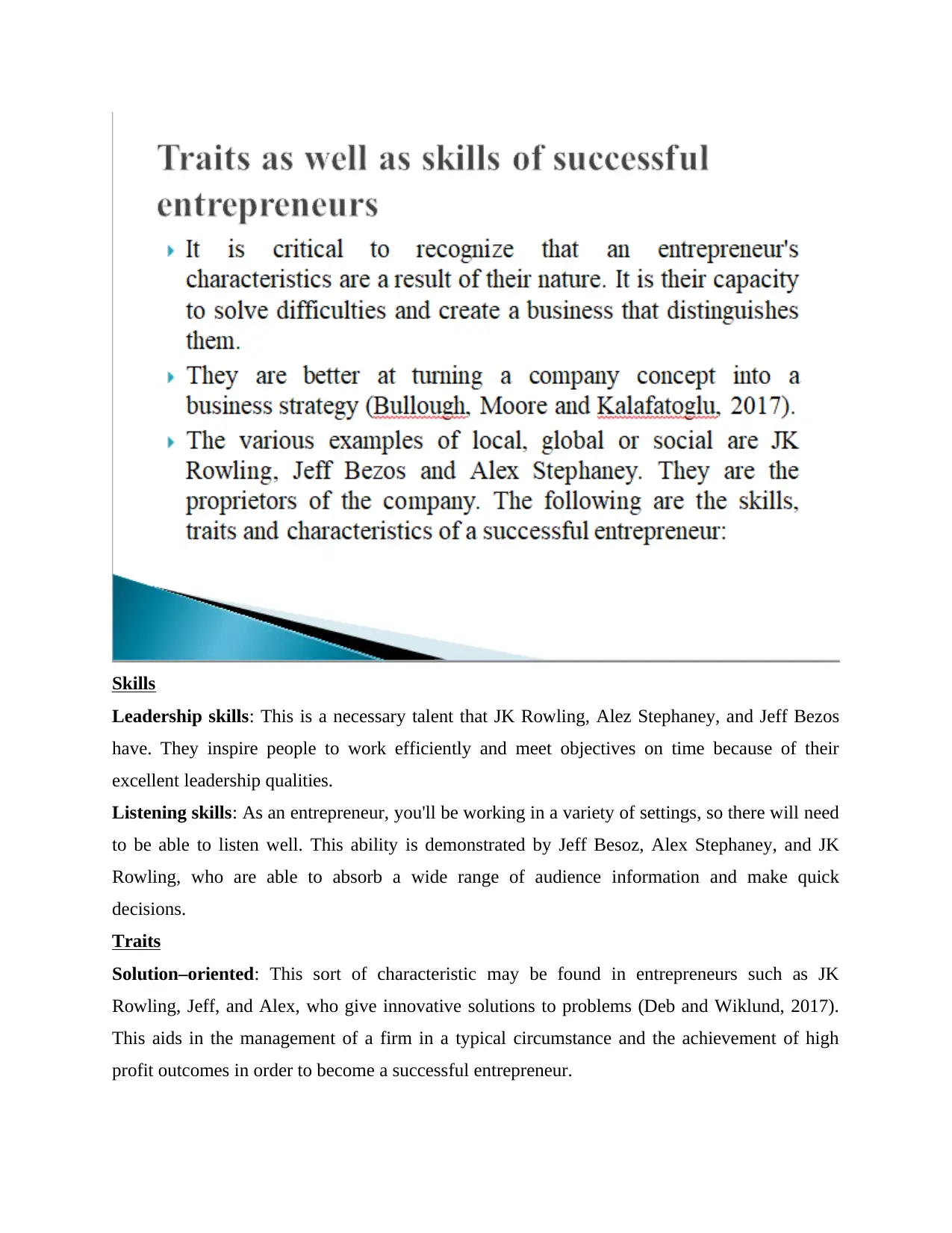
Skills
Leadership skills: This is a necessary talent that JK Rowling, Alez Stephaney, and Jeff Bezos
have. They inspire people to work efficiently and meet objectives on time because of their
excellent leadership qualities.
Listening skills: As an entrepreneur, you'll be working in a variety of settings, so there will need
to be able to listen well. This ability is demonstrated by Jeff Besoz, Alex Stephaney, and JK
Rowling, who are able to absorb a wide range of audience information and make quick
decisions.
Traits
Solution–oriented: This sort of characteristic may be found in entrepreneurs such as JK
Rowling, Jeff, and Alex, who give innovative solutions to problems (Deb and Wiklund, 2017).
This aids in the management of a firm in a typical circumstance and the achievement of high
profit outcomes in order to become a successful entrepreneur.
Leadership skills: This is a necessary talent that JK Rowling, Alez Stephaney, and Jeff Bezos
have. They inspire people to work efficiently and meet objectives on time because of their
excellent leadership qualities.
Listening skills: As an entrepreneur, you'll be working in a variety of settings, so there will need
to be able to listen well. This ability is demonstrated by Jeff Besoz, Alex Stephaney, and JK
Rowling, who are able to absorb a wide range of audience information and make quick
decisions.
Traits
Solution–oriented: This sort of characteristic may be found in entrepreneurs such as JK
Rowling, Jeff, and Alex, who give innovative solutions to problems (Deb and Wiklund, 2017).
This aids in the management of a firm in a typical circumstance and the achievement of high
profit outcomes in order to become a successful entrepreneur.
⊘ This is a preview!⊘
Do you want full access?
Subscribe today to unlock all pages.

Trusted by 1+ million students worldwide
1 out of 19
Related Documents
Your All-in-One AI-Powered Toolkit for Academic Success.
+13062052269
info@desklib.com
Available 24*7 on WhatsApp / Email
![[object Object]](/_next/static/media/star-bottom.7253800d.svg)
Unlock your academic potential
Copyright © 2020–2025 A2Z Services. All Rights Reserved. Developed and managed by ZUCOL.





